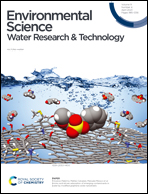The efficient treatment of pickling wastewater using a self-assembled in situ polymerized ceramic membrane with graphene/carbon nanotubes/polypyrrole†
Abstract
Ceramic membrane separation has been widely used in industrial wastewater treatment, but membrane contamination problems have limited its efficient and economical application. This study introduced reduced graphene oxide (rGO) and carbon nanotubes (CNTs) into the preparation of polypyrrole (PPy). Both rGO and CNTs were loaded on the surface layer of a ceramic membrane by an in situ oxidative polymerization-self-assembly method to form an rGO–CNT–PPy modified ceramic membrane, which was supplemented with an electric field effect to improve the antifouling performance. Characterization and electrochemical analysis indicated that the modified conductive ceramic composite membrane exhibited excellent electrical conductivity and stability, with an average square resistance of 78.9 Ω sq−1. The experimental results showed that TN, COD, NH3-N, Ni, Fe, and Cu were well removed under certain conditions with a removal efficiency of 63.60%, 64.00%, 68.31%, 89.90%, 95.04%, and 88.82%, respectively. Meanwhile, the pH of pickling wastewater increased from 2.61 to 6.63, and the membrane contamination was significantly improved. Furthermore, after 5 runs, the decay of membrane flux was less than 12%, and this modified conductive ceramic composite membrane was subjected to an electric field, which can effectively slow down the membrane contamination phenomenon. This approach based on the rGO–CNT–PPy modified conductive ceramic membrane provides a clean and effective technique for membrane contamination control.



 Please wait while we load your content...
Please wait while we load your content...